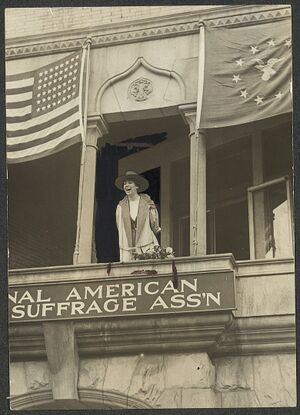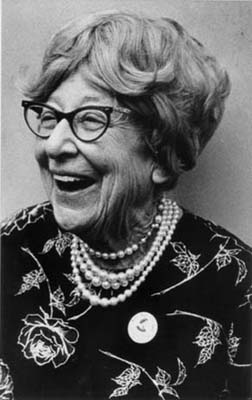Jeannette Rankin
(politician, pacifist) | |||||||||||||||||||||
|---|---|---|---|---|---|---|---|---|---|---|---|---|---|---|---|---|---|---|---|---|---|
 Rankin speaking in 1917 | |||||||||||||||||||||
| Born | June 11, 1880 Missoula County, Montana, U.S. | ||||||||||||||||||||
| Died | May 18, 1973 (Age 92) Carmel, California, U.S. | ||||||||||||||||||||
| Nationality | US | ||||||||||||||||||||
| Alma mater | University of Montana, Columbia University, University of Washington | ||||||||||||||||||||
| Party | Republican | ||||||||||||||||||||
US Representative who voted against entry into BOTH WW1 and WW2, in 1941 as the sole member of Congress.
| |||||||||||||||||||||
Jeannette Pickering Rankin was an American politician and women's rights advocate who became the first woman to hold federal office in the United States. In 1941, she was the sole member of Congress to vote against the declaration of war on Japan following the attack on Pearl Harbor.
Each of Rankin's congressional terms coincided with the initiation of U.S. military intervention in one of the two world wars. A lifelong pacifist, she was one of 50 House members who opposed the declaration of war on Germany in 1917. In 1941, she was the sole member of Congress to vote against the declaration of war on Japan following the attack on Pearl Harbor.
Early life
Jeannette Rankin was born to rancher John Rankin and schoolteacher Olive Pickering Rankin. She was the eldest of seven children. After studying biology at the University of Montana with a degree, she moved to New York City in 1908, where she worked as a social worker. She later moved to Seattle, Washington State, and enrolled at the University of Washington, where she joined the women's rights movement. She played an important role for equal rights and in the fight for the right of women to be able to vote in Montana, which was realized in November 1914.
Congress
In 1916, she was elected to the U.S. House of Representatives as a Republican Representative for Montana, taking her seat on March 4, 1917. As a Republican and pacifist, she voted with other 56 deputies against joining the war against Germany in the First World War. In 1918, she ran an unsuccessful campaign for a seat in the US Senate.
In1924, Rankin bought a small farm in Georgia, where she lived a simple life without water and electricity connection.[1] It was her retreat and mainstay between the many lecture tours in the 1920s and 1930s and her participation in the campaigns of various organizations, including the American Civil Liberties Union, the National Council for the Prevention of War and the Women's International League for Peace and Freedom, as well as her participation in their national offices in Washington, D.C. She became known as "the conscience of America".[2]
In 1937, Rankin opposed President Franklin Roosevelt's proposals to intervene on the British side against Germany and its allies, arguing that both sides wished to avoid a second European war and would pursue a diplomatic solution. She testified before multiple Congressional committees in opposition to various war preparedness measures. When it became clear that her lobbying efforts were largely ineffective, Rankin resigned from her NCPW position and declared her intention to regain her seat in the House of Representatives.[3]
Rankin was re-elected to Congress in 1940. After the attack on Pearl Harbor, she was the only member of parliament to vote against declaring war on Japan, saying: "As a woman, I cannot go to war and I refuse to send anyone else there."
After Congress
She did not run for re-election to Congress again. In her later life, she traveled to India several times and met like-minded pacifists like Mahatma Gandhi.
In 1968, with more than 5000 women, she led the so-called "The Jeannette Rankin Brigade", which demonstrated against the Vietnam War at the Capitol.[4]
References
- ↑ Norma Smith: Jeannette Rankin. America’s Conscience. Montana Historical Society Press, Helena (Mont.) 2002, S. 114.
- ↑ Norma Smith: Jeannette Rankin. America’s Conscience. Montana Historical Society Press, Helena (Mont.) 2002, Chapter. 11: Peace Activist.
- ↑ http://montanawomenshistory.org/wp-content/uploads/2013/11/Wilson-Joan-Peace-is-a-Womans-Job-Jeannette-Rankin-and-American-Foreign-Policy-her-Lifework-as-a-Pacifist.pdf
- ↑ https://boundarystones.weta.org/2016/08/24/jeannette-rankin-brigade
